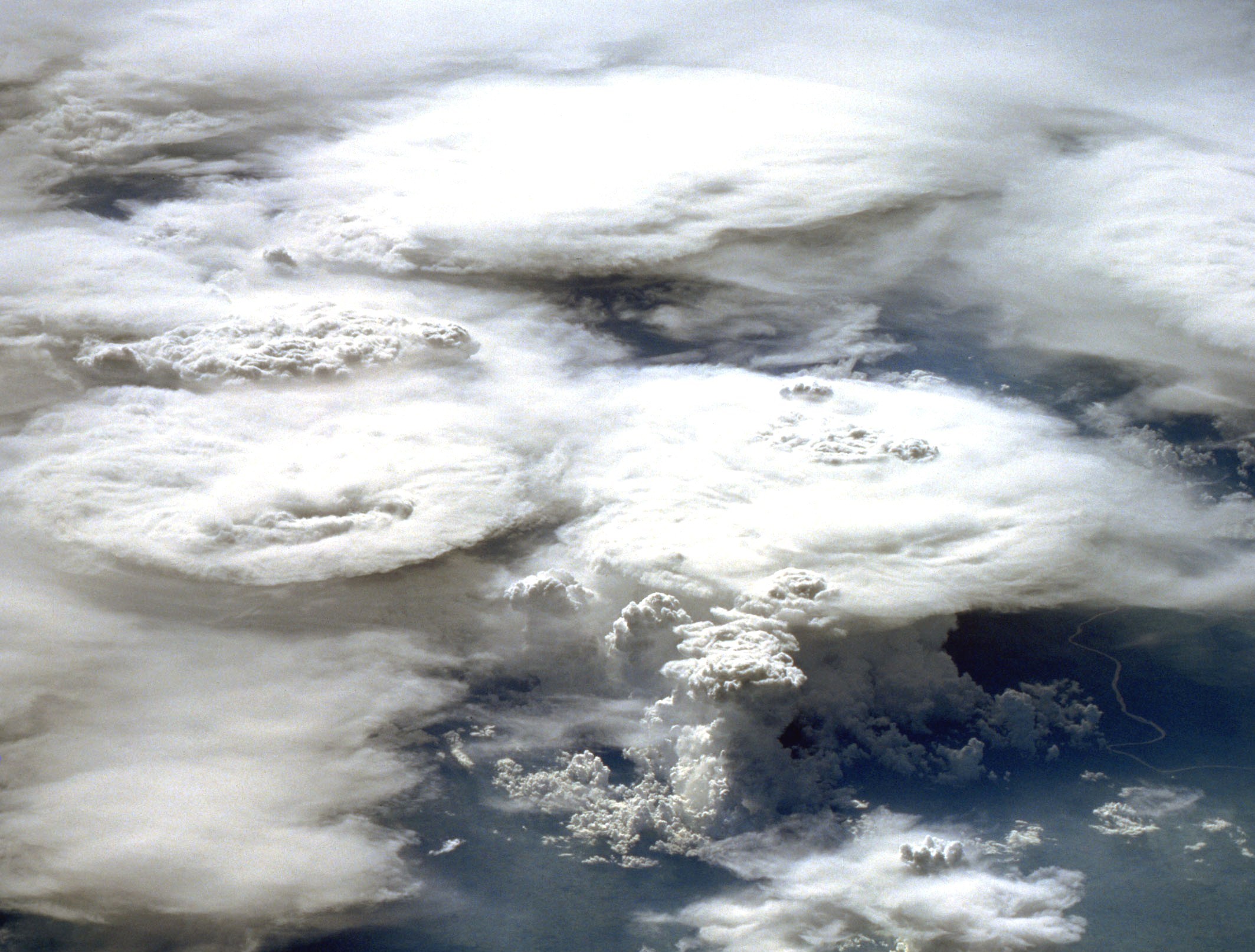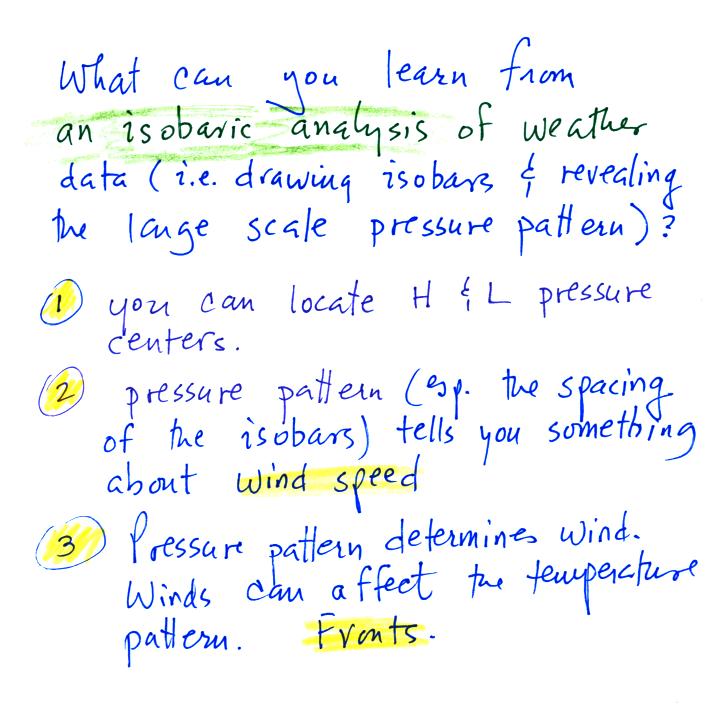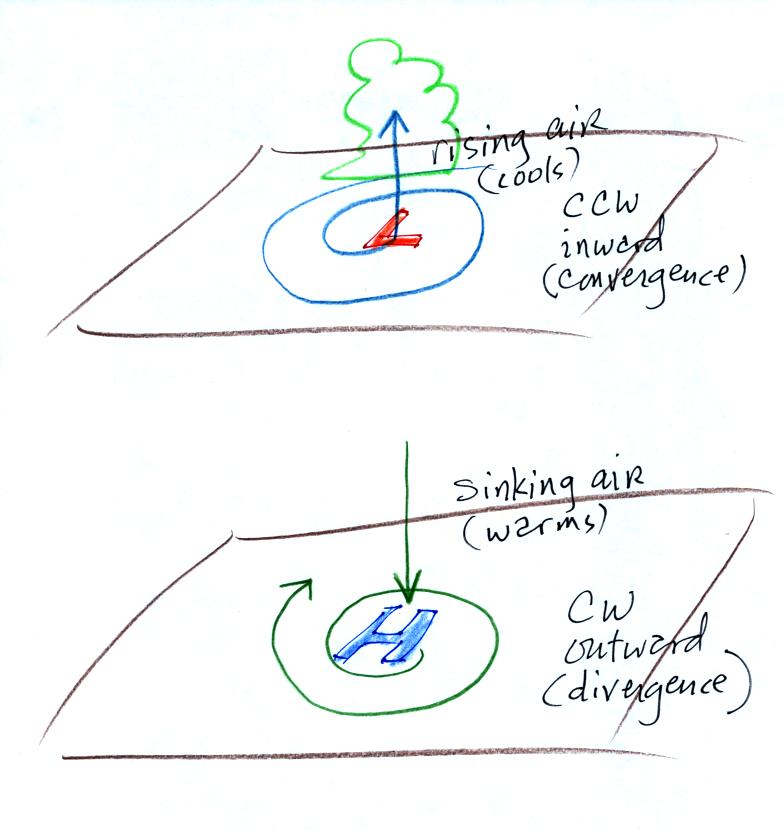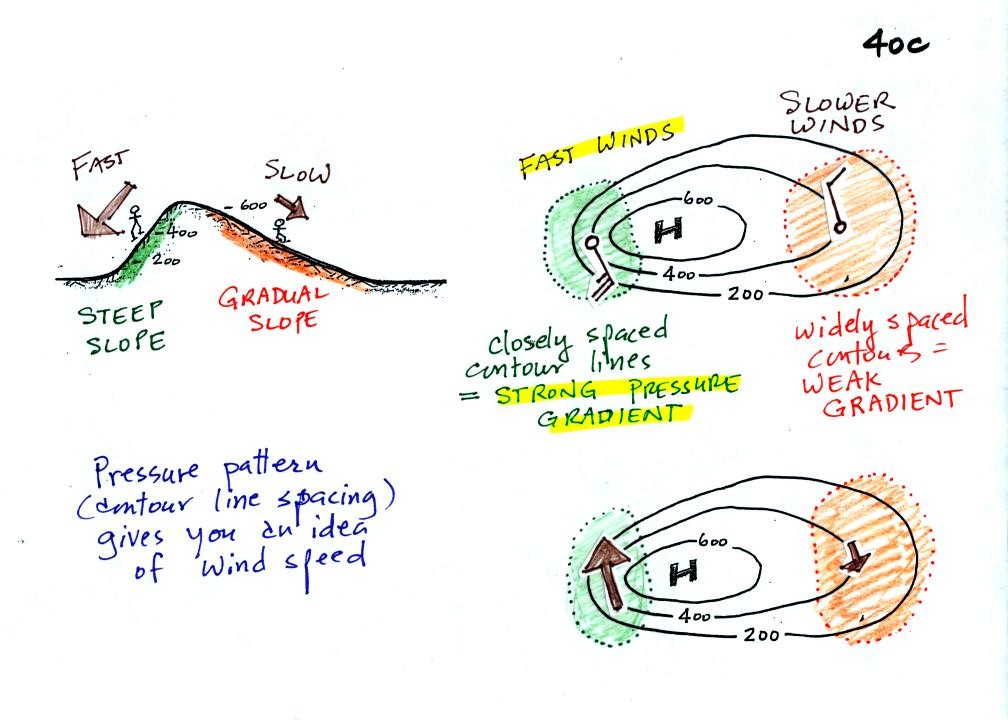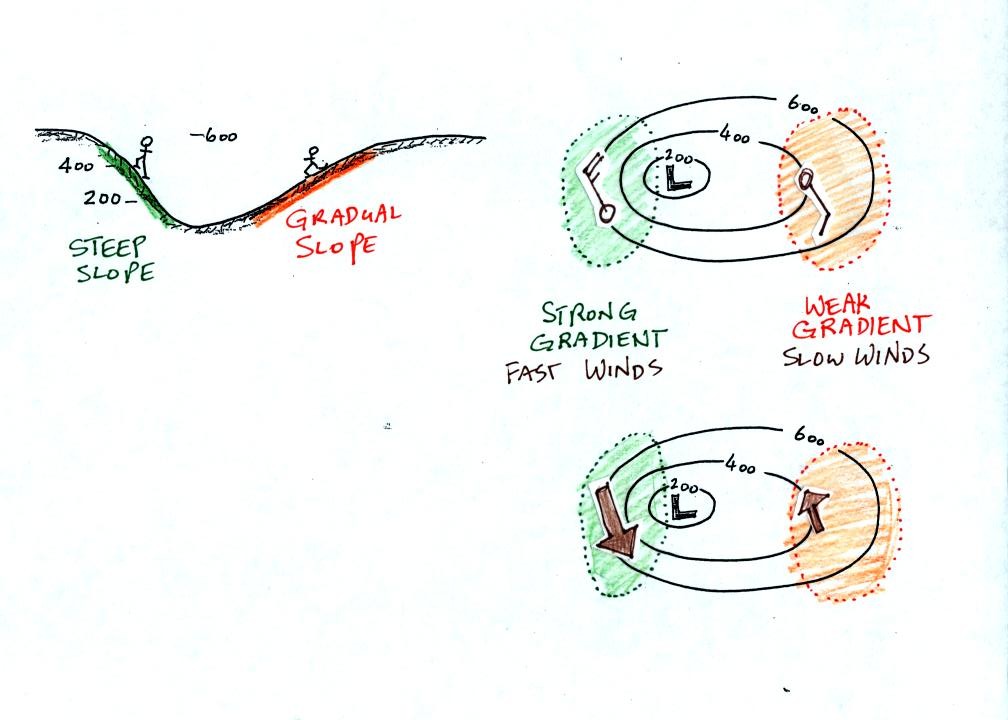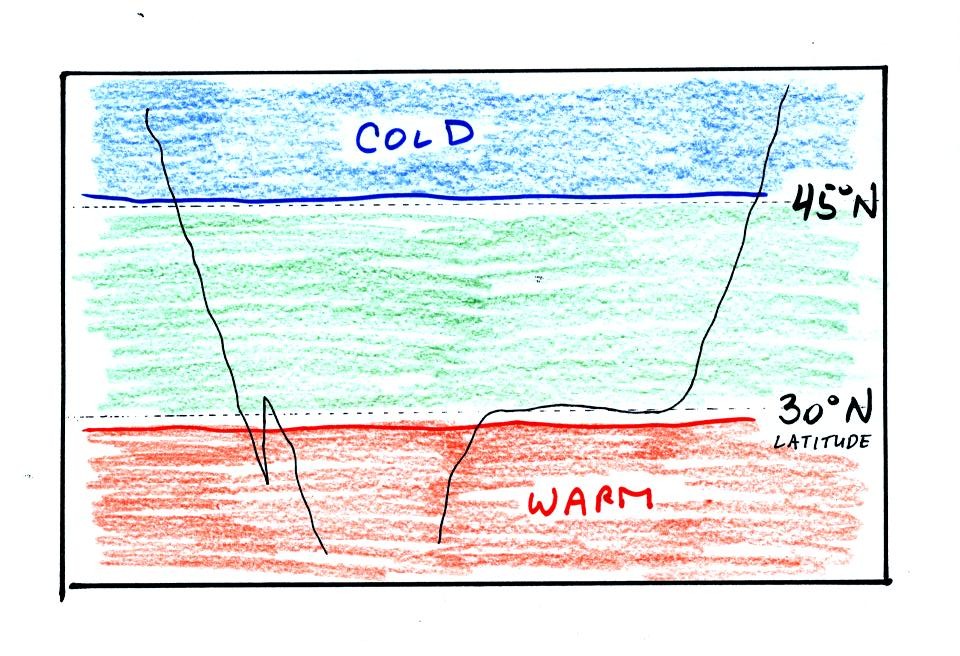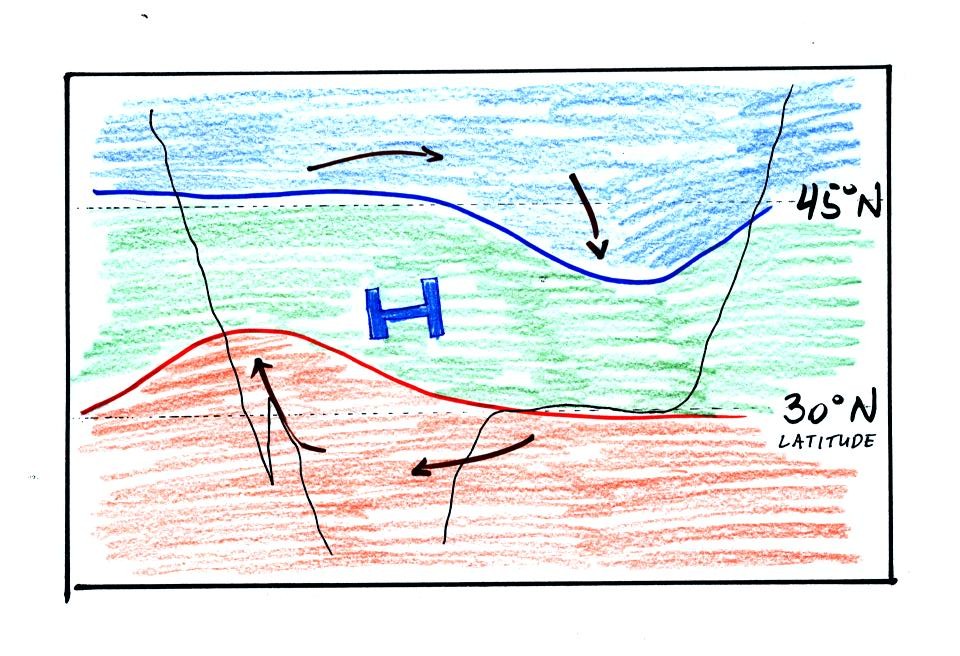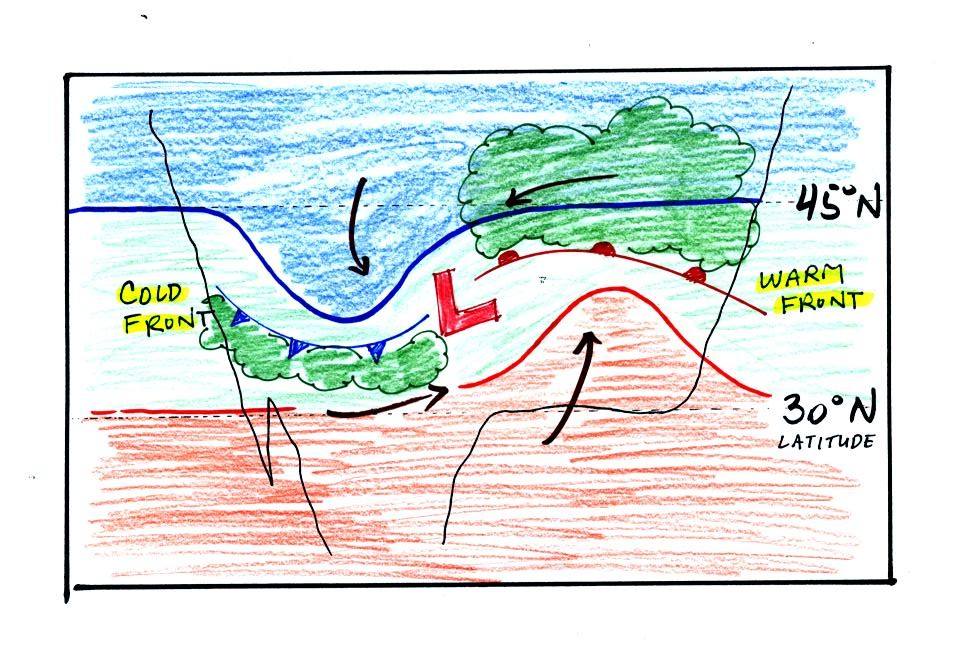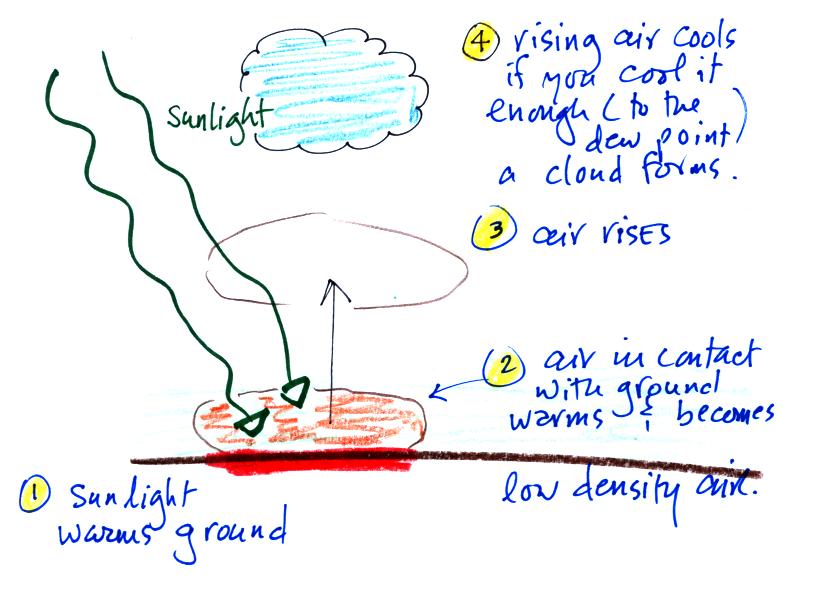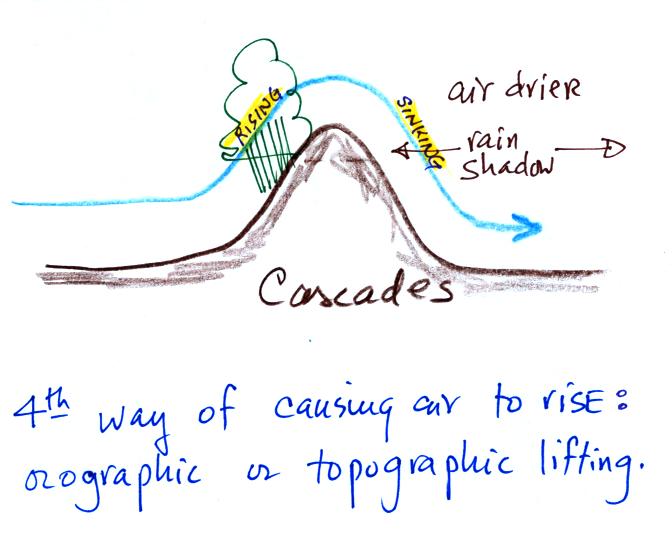Tue., Sep. 21, 2010
click here to download today's notes in
a more printer friendly format
Three songs from Xavier
Rudd before class today ("Guku", "Messages", and "Better
People").
A small section on the Ideal Gas Law (that had inadvertently
been left
off) has been added to the Quiz #1 Study Guide.
There won't be any questions from the last section on Upper Level
Charts on this week's quiz.
Here are answers to the Sep.
16 In-class Optional Assignment from last
Thursday. And here
are the answers to the Optional Assignment due
today (I won't be able to return that to you before the quiz on
Thursday)
The Experiment #2 materials will be handed
out before the quiz on
Thursday.
Trying out
a new feature in NATS 101 - an occasional Picture of the Day (whatever
strikes my fancy & and not necessarily weather related)
Tops of thunderstorms (anvil
clouds) viewed from the Space
Shuttle (source).
The
cloud
tops
are about 15 km high and flatten out when they reach the
top of the troposphere. Even powerful thunderstorms (over Brazil)
like these aren't able to push into the very stable air in the
stratosphere.
So you plot a bunch of weather data on a surface map using
the
station model notation and then draw in some isobars. What can
you learn from the resulting isobaric analysis? (I don't think I
actually wrote down this list in class on Tuesday)
1.
Here's a quick pictorial review of how
surface winds blow around
centers of low and high pressure (in the northern
hemisphere).
2.
The
pressure pattern will also tell you something about where you might
expect to find fast or slow winds. In this case we look for
regions where
the isobars are either closely spaced together or widely spaced.
Closely spaced contours means
pressure is changing
rapidly
with
distance. This is known as a strong pressure gradient and
produces fast winds. It is analogous to a steep slope on a
hillside. If you trip walking on a hill, you will roll rapidly
down a steep
hillside, more slowly down a gradual slope.
The winds around a high pressure
center are shown above using both the
station model notation and arrows. The winds are spinning clockwise and
spiraling outward slightly. Note the different wind speeds (25
knots and 10 knots plotted using the station model notation)
Winds spin counterclockwise and
spiral inward around
low
pressure
centers. The fastest winds are again found where the pressure
gradient is strongest.

This figure is found at the bottom
of p. 40 c in the photocopied ClassNotes. You should be able to
sketch in the direction of the wind at each of the three
points and determine where the fastest and slowest winds would be
found. (you'll find the answers at the end of today's notes).
3.
The
pressure pattern determines the wind direction and wind
speed. Once the winds start to blow they can affect and change
the temperature pattern. The figure below shows the
temperature pattern you would
expect to see if the wind wasn't blowing at all or if the wind was
blowing straight from west to east. The bands of different
temperature are aligned parallel to the lines of latitude.
Temperature changes from south to north but not from west to
east. The figures below are more cleaner and neater versions of
what was drawn in class (the figures in class may also have had 60 N
latitude instead of the 45 shown here - don't worry about that).
This isn't a very interesting
picture. It gets a
little
more interesting if you put centers of high or low pressure in the
middle.
The clockwise spinning winds
move warm air to
the north on
the western
side of the High. Cold air moves toward the south on the eastern
side of the High. The diverging winds also move the warm and cold
air away from the center of the High.
Counterclockwise winds move cold air toward the south
on the
west side
of the Low. Warm air advances toward the north on the eastern
side of the low.
The converging winds in the case of low pressure will move the air
masses of different temperature in toward the center of low pressure
and cause them to collide with each other. The boundaries between
these colliding air masses are called fronts. Fronts are a second
way
of causing rising air motions (rising air expands and cools, if the air
is moist clouds can form)
Cold air is moving from north toward the south on the
western side of
the low. The leading edge of the advancing cold air mass is a
cold front. Cold fronts are drawn in blue on weather maps.
The small triangular symbols on the side of the front identify it as a
cold front and show what direction it is moving. The fronts are
like spokes on a wheel. The "spokes" will spin counterclockwise
around the low pressure center (the axle).
A warm front (drawn in red with half circle symbols) is shown on the
right hand side of the map at the advancing edge of warm air. It
is also rotating counterclockwise around the Low.
This
type of storm system is referred to
as an extratropical cyclone
(extra tropical means outside the tropics, cyclone means winds spinning
around low pressure) or a middle latitude storm. Large
storms also
form in the tropics, they're called tropical cyclones or more commonly
hurricanes.
Clouds can form along fronts (often in a fairly narrow band along
a
cold front and over a larger area ahead of a warm front). We need
to look at the crossectional structure of warm and cold fronts to
understand better why this is the case.
The top picture below shows a crossectional
view of a cold front
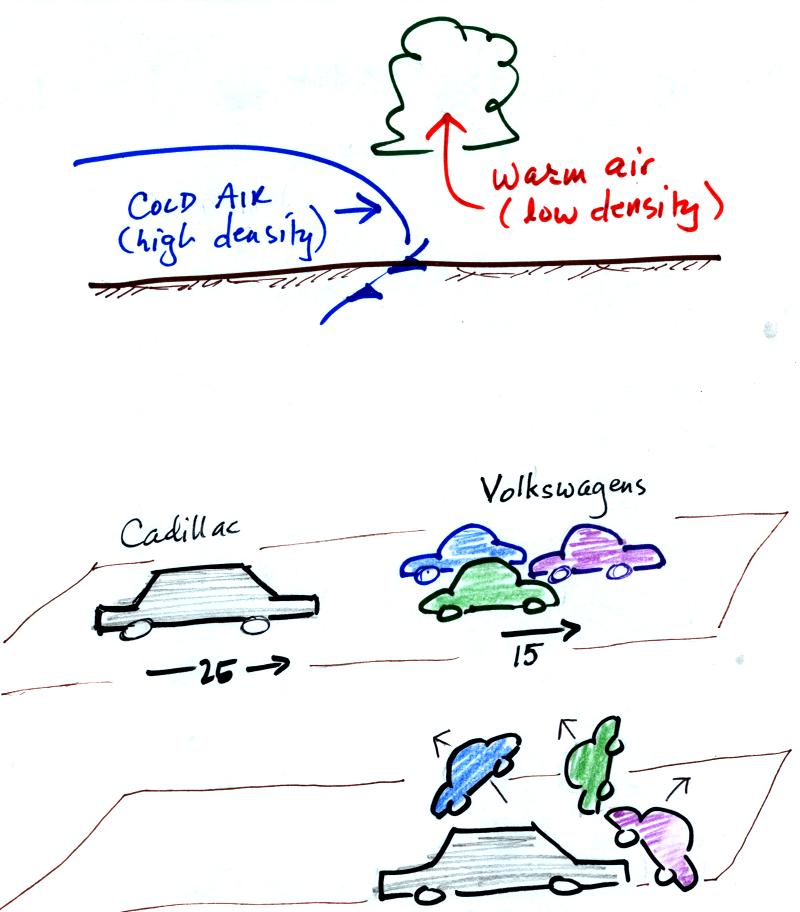
At the top of the figure, cold
dense air on the left is
advancing into
warmer lower density air
on the right. We are looking at the front edge of the cold air
mass, note the blunt shape. The front edge of the advancing cold
air "bunches up" because of friction as it moves across the
ground. The warm low density air is lifted
out of the way
by the cold air. The warm air is rising.
The lower figure shows an analogous situation, a big heavy
Cadillac
plowing into a bunch of
Volkswagens. The VWs are thrown up into the air by the Cadillac.
Here's a crossectional view of a
warm front, the structure is a
little different.
In the case of a warm
front we are looking
at
the
back,
trailing edge of cold air (moving slowly to the right). Note the
ramp
like shape of the cold air mass. Warm air overtakes the cold
air. The warm air is still less dense than the cold air, it can't
wedge its way underneath the cold air. Rather the warm air
overruns the cold air. The warm air rises again (more gradually)
and clouds form. The clouds generally are spread out over a
larger area than with cold fronts. The front can advance only as
fast as the cooler air moves away to the right.
In the automobile analogy, the VWs are catching a
Cadillac. What
happens
when they overtake the Cadillac?

The Volkswagens
aren't heavy
enough to lift the
Cadillac.
They run up and over the Cadillac.
Fronts
are
a
second
way of
causing air to rise. Rising air cools and if the
warm air
is moist and cooled enough, clouds and precipitation can form.
That's why the clouds were drawn in along the fronts in the middle
latitude storm picture above.
Here's the surface map that we were working with last week.
Cold and warm fronts have been added. The cold front is almost
certainly what is responsible for the rain shower along the Gulf
Coast. The warm front is probably the main cause of the rain and
drizzle in the NE portion of the map.
We will come back to the topic of fronts again.
We
will, in particular, learn about some of the weather changes that take
place as a front approaches and passes through. We will also look
at how fronts can be located on surface weather maps.
As long as
we're listing weather processes that can cause air to rise we might as
well mention the 3rd process. It's something we've already sort
of covered as a matter of fact.
Topographic or Orographic lifting
is the 4th way of causing air to
rise.
When moving air encounters a mountain it must pass over
it. You often find clouds and rain on the windward side of the
mountain where the air rises. Drier conditions, a rain shadow, is
found on the leeward side where the air is sinking (assuming that the
winds mostly blow in the same direction over the mountain).
We've been
spending some time
learning about surface weather
maps. Maps
showing conditions at various altitudes above the ground are also
drawn.
Upper level conditions can affect the development and movement of
surface
features (and vice versa)
We had just enough time to
learn three basic things about upper level
charts.
This material
won't be on this week's quiz.
First the overall appearance is somewhat different from a surface
weather
map. The pattern on a surface map can be complex and you
generally find circular (more or less)
centers
of high and low pressure. You can also find closed high and low
pressure
centers at upper levels, but mostly you find a relatively simple wavy
pattern like
sketched
below.
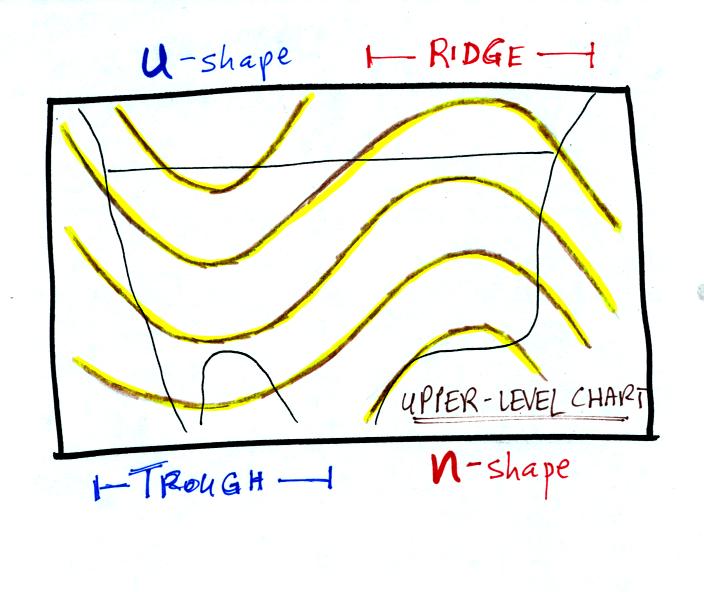
The u-shaped
portion of the pattern is called a trough. The n-shaped portion
is called
a ridge.

Troughs
are
produced
by
large
volumes
of
cool or cold air
(the cold air is found between the ground and the upper level that the
map
depicts). The western half of the country in the map above would
probably
be experiencing colder than average temperatures. Large volumes
of warm
or hot air produce ridges.
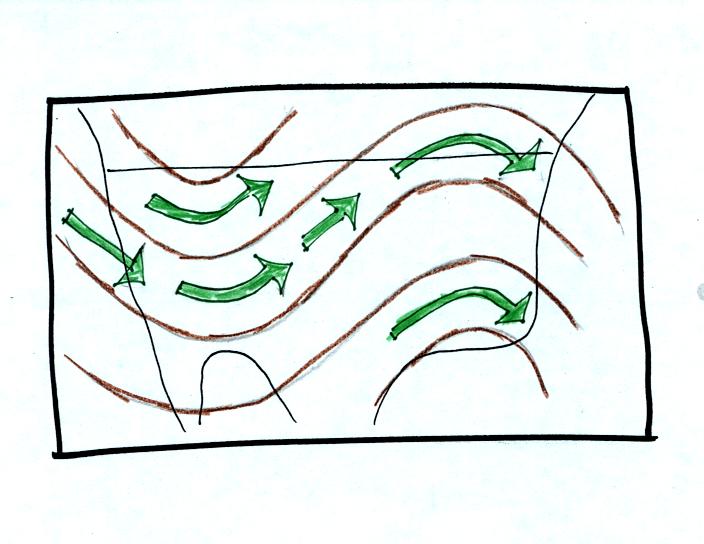
The
winds on upper level charts blow parallel to the contour lines (on a
surface map the winds cross the isobars slightly, spiralling into
centers of
low pressure and outward away from centers of high pressure). The
upper
level winds generally blow from west to east.
Next looked at some of the interactions between features on surface and
upper
level charts. This material is more difficult and
confusing. Feel free to skip
this material at this point.
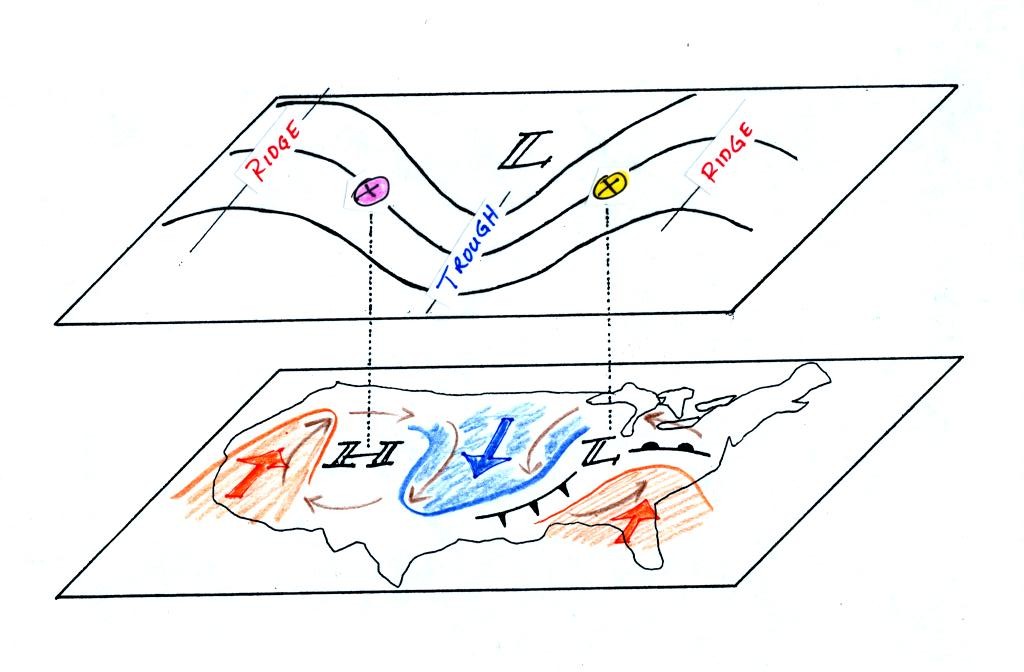
On
the surface map you see centers of HIGH and LOW pressure. The
surface low
pressure center, together with the cold and warm fronts, is a middle
latitude
storm.
Note how the counterclockwise winds spinning around the LOW move warm
air
northward (behind the warm front on the eastern side of the LOW) and
cold air
southward (behind the cold front on the western side of the LOW).
Clockwise winds spinning around the HIGH also move warm and cold
air. The
surface winds are shown with thin brown arrows on the surface map.
Note the ridge and trough features on the upper level chart. We
learned
that warm air is found below an upper level ridge. Now you can
begin to
see where this warm air comes from. Warm air is found west of the
HIGH
and to the east of the LOW. This is where the two ridges on
the
upper level chart are also found. You expect to find cold air
below an
upper level trough. This cold air is being moved into the middle
of the
US by the northerly winds that are found between the HIGH and the
LOW.
Note the yellow X marked on the upper level chart directly above the
surface
LOW. This is a good location for a surface LOW to form, develop,
and
strengthen (strengthening means the pressure in the surface low will
get even
lower than it is now. This is also called "deepening"). The
reason for this is that the yellow X
is a
location where there is often upper level divergence. Similary
the pink X
is where you often find upper level convergence. This could cause
the
pressure in the center of the surface high pressure to get even higher.
We didn't cover this next section in class (we didn't have enough time
and I don't like covering potentially confusing material like this
right before a quiz even if it won't be appear on the quiz). This
section examines in more detail how upper level winds can
affect the
development or intensification of a surface storm.
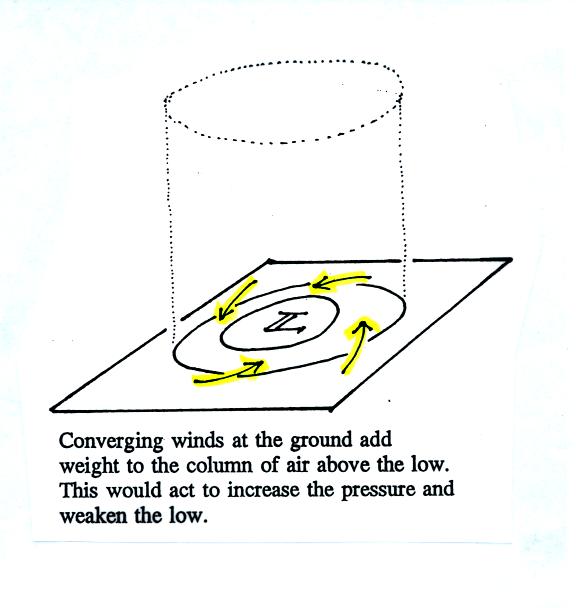
This
figure (see p. 42 in the photocopied Classnotes) shows a cylinder of
air
positioned above a surface low pressure center. The pressure at
the
bottom of the cylinder is determined by the weight of the air
overhead.
The surface winds are spinning counterclockwise and spiraling in toward
the center
of the surface low. These converging surface winds add air to the
cylinder. Adding air to the cylinder means the cylinder will
weigh more
and you would expect the surface pressure at the bottom of the cylinder
to
increase.
We'll just make up some numbers, this might make things clearer.
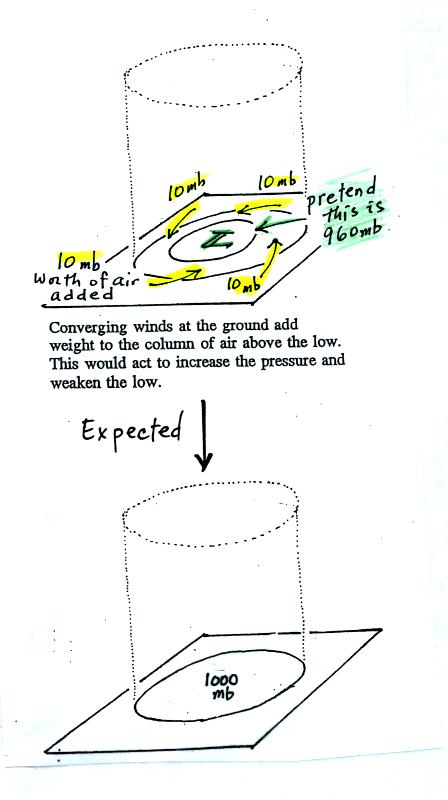
You'll
find this figure on p. 42a in the Class Notes. We will assume the
surface
low has 960 mb pressure. Imagine that each of the surface
wind
arrows brings in enough air to increase the pressure at the center of
the LOW
by 10 mb. You would expect the pressure at the center of the LOW
to
increase from 960 mb to 1000 mb.
This is just like a bank account. You have $960 in the bank and
you make
four $10 dollar deposits. You would expect your bank account
balance to
increase from $960 to $1000.
But what if the surface pressure decreased from 960 mb to 950 mb as
shown in
the following figure? Or in terms of the bank account, wouldn't
you be
surprised if, after making four $10 dollar deposits, the balance went
from
$960 to $950.
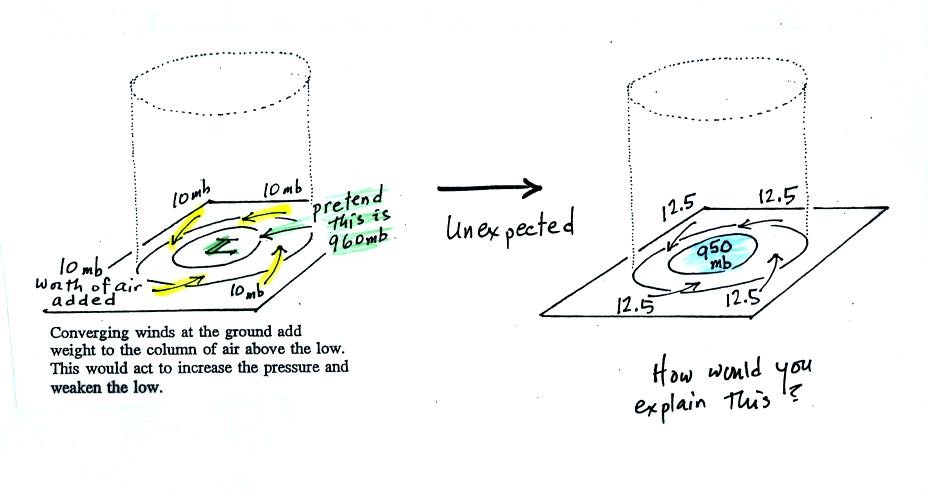
The
next figure shows us what could be happening (back to p. 42 in the
Class
Notes).
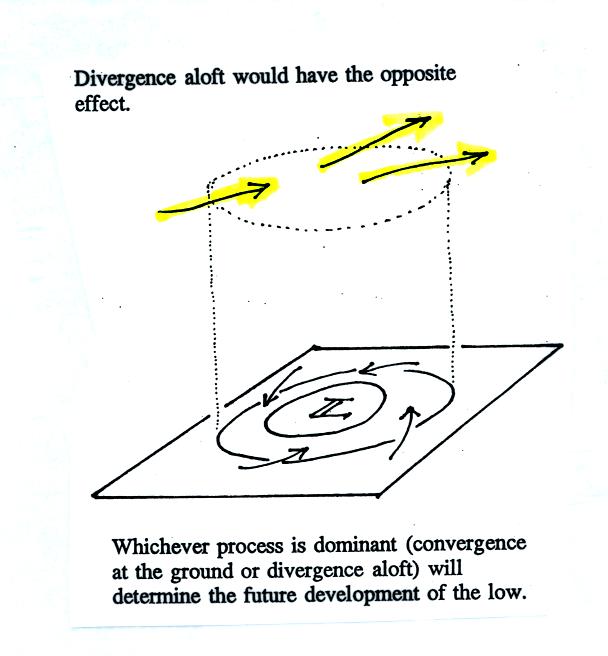
There
may be some upper level divergence (more arrows leaving the cylinder at
some
point above the ground than going in ). Upper level divergence
removes
air from the cylinder and would decrease the weight of the cylinder
(and that
would lower the surface pressure)
We need to determine which of the two (converging winds at the surface
or
divergence at upper levels) is dominant. That will determine what
happens
to the surface pressure.
Again some actual numbers might help (see p. 42b in the Class Notes)

The
40 millibars worth of surface convergence is shown at Point 1. Up
at
Point 2 there are 50 mb of air entering the cylinder but 100 mb
leaving.
That is a net loss of 50 mb. At Point 3 we see the overall
result, a net
loss of 10 mb. The surface pressure should decrease from 960 mb
to 950
mb. That change is reflected in the next picture (found at the
bottom of
p. 42b in the Class Notes).
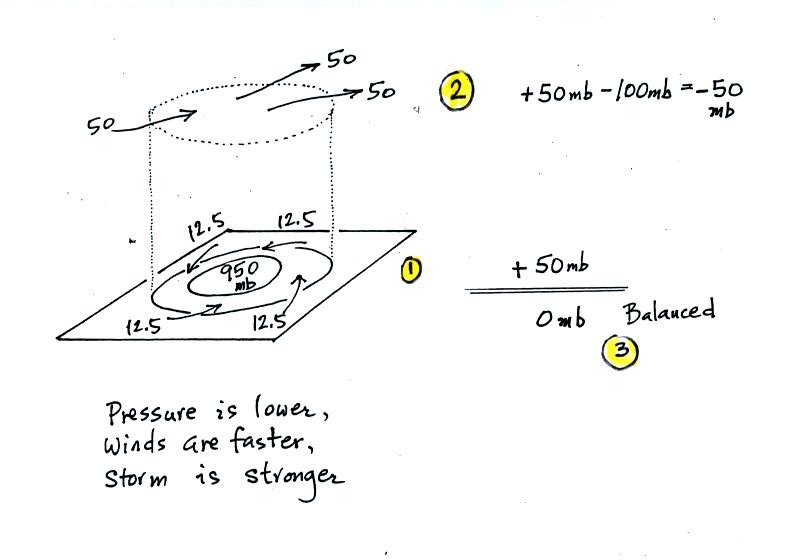
The
surface
pressure
is
950
mb.
This
means there is
more of a pressure difference between the low pressure in the center of
the
storm and the pressure surrounding the storm. The surface storm
has
intensified and the surface winds will blow faster and carry more air
into the
cylinder (the surface wind arrows each now carry 12.5 mb of air instead
of 10
mb). The converging surface winds add 50 mb of air to the
cylinder (Point
1), the upper level divergence removes 50 mb of air from the cylinder
(Point
2). Convergence and divergence are in balance (Point 3).
The storm
won't intensify any further.
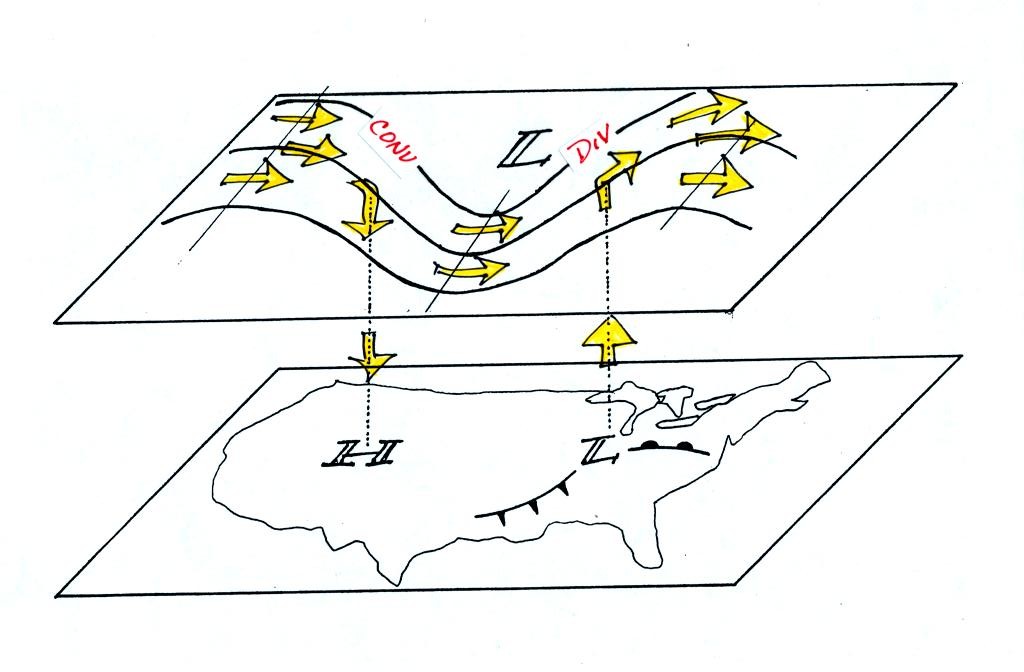
Now
that you have some idea of what upper level divergence looks like (more
air
leaving than is going in) you are in a position to understand another
one of
the relationships between the surface and upper level winds.
One of the things we have learned about surface LOW pressure is that
the
converging surface winds create rising air motions. The figure
above
gives you an idea of what can happen to this rising air (it has to go
somewhere). Note the upper level divergence in the figure: two
arrows of
air coming into the point "DIV" and three arrows of air leaving (more
air going out than coming in is what makes this divergence). The
rising
air can, in effect, supply the extra arrow's worth of air.
Three arrows of air come into the point marked "CONV" on the upper
level chart and two leave (more air coming in than going out).
What
happens to the extra arrow? It sinks, it is the source of the
sinking air
found above surface high pressure.
